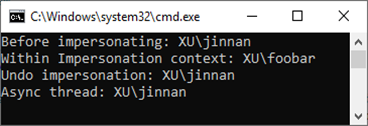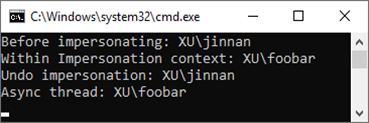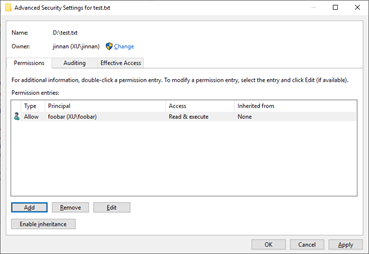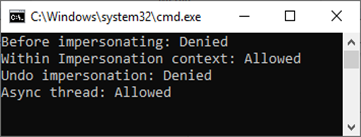从执行上下文角度重新理解.NET(Core)的多线程编程[3]:安全上下文
在前两篇文章(《基于调用链的”参数”传递》和《同步上下文》)中,我们先后介绍了CallContext(IllogicalCallContext和LogicalCallContext)、AsyncLocal<T>和SynchronizationContext,它们都是线程执行上下文的一部分。本篇介绍的安全上下文(SecurityContext)同样是执行上下文的一部分,它携带了的身份和权限相关的信息决定了执行代码拥有的控制权限。
目录
一、SecurityContext
二、让代码在指定Windows账号下执行
三、抑制模拟账号的跨线程传播
四、利用Impersonation机制读取文件
一、SecurityContext
SecurityContext类型表示的安全上下文主要携带两种类型的安全信息,一种是通过WindowsIdentity对象表示Windows认证身份,体现为SecurityContext类型的WindowsIdentity属性。如果采用Windows认证和授权,这个WindowsIdentity对象决定了当前代码具有的权限。SecurityContext类型的另一个属性返回的CompressedStack携带了调用堆栈上关于CAS(Code Access Security)相关的信息。。
public sealed class SecurityContext : IDisposable { ... internal WindowsIdentity WindowsIdentity { get; set; } internal CompressedStack CompressedStack { get; set; } }
由于CAS在.NET Core和.NET 5中不再被支持,所以我们不打算对此展开讨论,所以本篇文章讨论的核心就是SecurityContext的WindowsIdentity属性返回的WindowsIdentity对象,这个对象与一种被称为Impersonation的安全机制。
二、让代码在指定Windows账号下执行
Windows进程总是在一个指定账号下执行,该账号决定了当前进程访问Windows资源(比如Windows文件系统)的权限。安全起见,我们一般会选择一个权限较低的账号(比如Network Service)。如果某些代码涉及的资源访问需要更高的权限,我们可以针对当前登录用户对应的Windows账号(如果采用Windows认证)或者是任意指定的Windows账号创建一个上下文,在此上下文中的代相当于在指定的Windows账号下执行,自然拥有了对应账号的权限。这种策略相当于模拟/假冒了(Impersonate)了指定账号执行了某种操作,所以我们将这种机制称为Impersonation。
我们通过一个简单的例子来演示一下Impersonation机制。我们首先编写了如下这个GetWindowsIdentity方法根据指定的账号和密码创建对应的WindowsIdentity对象。如代码片段所示,方法利用指定的用户名和密码调用了Win31函数LogonUser实施了登录操作,并领用返回的token创建代码登录用户的WindowsIdentity对象。
[DllImport("advapi32.dll")] public static extern int LogonUser(string lpszUserName, string lpszDomain, string lpszPassword, int dwLogonType, int dwLogonProvider, ref IntPtr phToken); public static WindowsIdentity GetWindowsIdentity(string username, string password) { IntPtr token = IntPtr.Zero; var status = LogonUser(username, Environment.MachineName, password, 2, 0, ref token); if (status != 0) { return new WindowsIdentity(token); } throw new InvalidProgramException("Invalid user name or password"); }
我们编写了如下的代码来演示不同执行上下文中当前的Windows账号是什么,当前Windows账号对应的WindowsIdentity对象通过调用WindowsIdentity类型的静态方法GetCurrent获得。如代码片段所示,我们在程序初始化时打印出当前Windows账号。然后针对账号foobar(XU\foobar)创建了对应的模拟上下文(Impersonation Context),并在此上下文中打印出当前Windows账号。我们在模拟上下文中通过创建一个线程的方式执行了一个异步操作,并在异步线程中在此输出当前Windows账号。在模拟上下文终结之后,我们在此输出当前的Windows账号看看是否恢复到最初的状态。
class Program { static void Main() { Console.WriteLine("Before impersonating: {0}", WindowsIdentity.GetCurrent().Name); using (GetWindowsIdentity(@"foobar", "password").Impersonate()) { Console.WriteLine("Within Impersonation context: {0}", WindowsIdentity.GetCurrent().Name); new Thread(() => Console.WriteLine("Async thread: {0}", WindowsIdentity.GetCurrent().Name)).Start(); } Console.WriteLine("Undo impersonation: {0}", WindowsIdentity.GetCurrent().Name); Console.Read(); } }
程序运行之后,控制台上会输出如下所示的结果。可以看出在默认情况下,模拟的Windows账号不仅在当前线程中有效,还会自动传递到异步线程中。
三、抑制模拟账号的跨线程传播
通过上面的实例我们可以看出在默认情况下安全上下文携带的模拟Windows账号支持跨线程传播,但是有的时候这个机制是不必要的,甚至会代码安全隐患,在此情况下我们可以按照如下的当时调用SecurityContext的
class Program { static void Main() { Console.WriteLine("Before impersonating: {0}", WindowsIdentity.GetCurrent().Name); using (GetWindowsIdentity(@"foobar", "password").Impersonate()) { SecurityContext.SuppressFlowWindowsIdentity(); Console.WriteLine("Within Impersonation context: {0}", WindowsIdentity.GetCurrent().Name); new Thread(() => Console.WriteLine("Async thread: {0}", WindowsIdentity.GetCurrent().Name)).Start(); } Console.WriteLine("Undo impersonation: {0}", WindowsIdentity.GetCurrent().Name); Console.Read(); } }
再次执行修改后的程序会得到如下所示的输出结果,可以看出模拟的Windows账号(XU\foobar)并没有传递到异步线程中。
四、利用Impersonation机制读取文件
访问当前账号无权访问的资源是Impersonation机制的主要应用场景,接下来我们就来演示一下基于文件访问的Impersonation应用场景。我们创建了一个文本文件d:\test.txt,并对其ACL进行如下的设置:只有Xu\foobar账号才具有访问权限。
我们修改了上面的代码,将验证当前Windows账号的代码替换成验证文件读取权限的代码。
class Program { static void Main() { Console.WriteLine("Before impersonating: {0}", CanRead() ? "Allowed" : "Denied"); using (GetWindowsIdentity("foobar", "password").Impersonate()) { Console.WriteLine("Within Impersonation context: {0}", CanRead() ? "Allowed" : "Denied"); new Thread(() => Console.WriteLine("Async thread: {0}", CanRead() ? "Allowed" : "Denied")).Start(); } Console.WriteLine("Undo impersonation: {0}", CanRead() ? "Allowed" : "Denied"); Console.Read(); bool CanRead() { var userName = WindowsIdentity.GetCurrent().Name; try { File.ReadAllText(@"d:\test.txt"); return true; } catch { return false; } } } }
如下所示程序执行后的输出结果,可以看出在文件只有在针对XU\foobar的模拟上下文中才能被读取。如果执行模拟WindowsIdentity的跨线程传播,异步线程也具有文件读取的权限(如图),否则在异步线程中也无法读取该文件(感兴趣的朋友可以自行测试一下)。
从执行上下文角度重新理解.NET(Core)的多线程编程[1]:基于调用链的”参数”传递
从执行上下文角度重新理解.NET(Core)的多线程编程[2]:同步上下文
从执行上下文角度重新理解.NET(Core)的多线程编程[3]:安全上下文


 在前两篇文章中,我们先后介绍了CallContext(IllogicalCallContext和LogicalCallContext)、AsyncLocal和SynchronizationContext,它们都是线程执行上下文的一部分。本篇介绍的安全上下文(SecurityContext)同样是执行上下文的一部分,它携带了的身份和权限相关的信息决定了执行代码拥有的控制权限。
在前两篇文章中,我们先后介绍了CallContext(IllogicalCallContext和LogicalCallContext)、AsyncLocal和SynchronizationContext,它们都是线程执行上下文的一部分。本篇介绍的安全上下文(SecurityContext)同样是执行上下文的一部分,它携带了的身份和权限相关的信息决定了执行代码拥有的控制权限。





 蒋金楠,网名Artech,大内老A,知名IT博主, 微软多领域MVP,畅销IT图书作者。
蒋金楠,网名Artech,大内老A,知名IT博主, 微软多领域MVP,畅销IT图书作者。








【推荐】国内首个AI IDE,深度理解中文开发场景,立即下载体验Trae
【推荐】编程新体验,更懂你的AI,立即体验豆包MarsCode编程助手
【推荐】抖音旗下AI助手豆包,你的智能百科全书,全免费不限次数
【推荐】轻量又高性能的 SSH 工具 IShell:AI 加持,快人一步
· AI与.NET技术实操系列:向量存储与相似性搜索在 .NET 中的实现
· 基于Microsoft.Extensions.AI核心库实现RAG应用
· Linux系列:如何用heaptrack跟踪.NET程序的非托管内存泄露
· 开发者必知的日志记录最佳实践
· SQL Server 2025 AI相关能力初探
· winform 绘制太阳,地球,月球 运作规律
· 震惊!C++程序真的从main开始吗?99%的程序员都答错了
· AI与.NET技术实操系列(五):向量存储与相似性搜索在 .NET 中的实现
· 超详细:普通电脑也行Windows部署deepseek R1训练数据并当服务器共享给他人
· 【硬核科普】Trae如何「偷看」你的代码?零基础破解AI编程运行原理
2018-11-27 Dora.Interception,为.NET Core度身打造的AOP框架 [5]:轻松地实现与其他AOP框架的整合
2010-11-27 《老男孩》——记录我们逝去的青春
2008-11-27 Enterprise Library深入解析与灵活应用(6):自己动手创建迷你版AOP框架
2007-11-27 谈谈WCF中的Data Contract(4):WCF Data Contract Versioning
2007-11-27 谈谈WCF中的Data Contract(3):WCF Data Contract对Collection & Dictionary的支持
2007-11-27 谈谈WCF中的Data Contract(2):WCF Data Contract对Generic的支持
2007-11-27 谈谈WCF中的Data Contract (1):Data Contract Overview